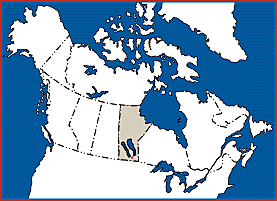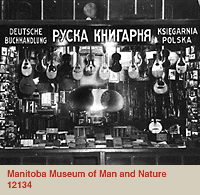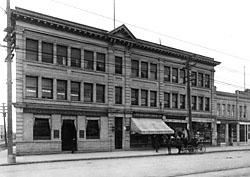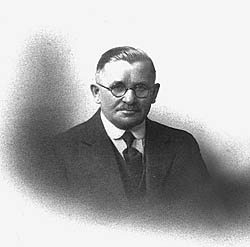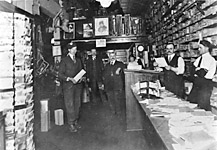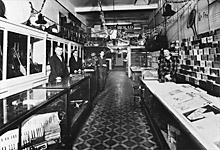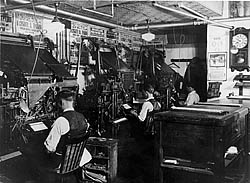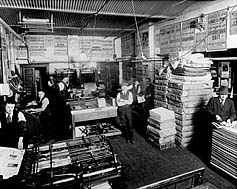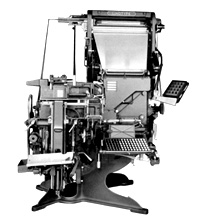
|


|
3. Many Voices — Language and
Culture in Manitoba
|
Along with two other Canada Hall modules, the Union Hall and the Chinese
Hand Laundry, the Crump Block and its two shop fronts, the Book and
Music Supply Store and Print Shop, together form a street scene in
Winnipeg during the first half of the twentieth century.
The Book and Music Supply StoreThe waves of settlers brought diverse cultures and a multitude of languages to the Prairie region, placing their own imprint on its economic and social life. East European groups were especially visible in the new cultural landscape and eventually made up close to a third of the Prairie population. Many commercial enterprises emerged to cater to their cultural needs. Ethnic Entrepreneur The first of the two exhibition modules in Many Voices – Language and Culture in Manitoba faithfully reproduces the combined business of Ukrainian Booksellers and Publishers and Winnipeg Musical Supply Co., a highly successful multi-ethnic business founded by Czech immigrant Frank Dojacek. Selling such items as newspapers, religious goods, ethnic records and folk art supplies, the store catered to a dozen different ethnic groups and served as a veritable resource centre for cultural survival.
Frank Dojacek (1880-1951) acted as a bridge between the Old and New Worlds for thousands of immigrants settling in Western Canada. Born in Vlasim, Bohemia in what is now the Czech Republic, he immigrated to Winnipeg in 1903. Although trained as a tailor, he soon became a door-to-door book peddler. In 1906 he founded what became Ukrainian Booksellers and in 1911 moved the business to the Crump Block at 850 Main Street, Winnipeg where he remained until the mid-1920s. It is this shop location that has been recreated in the Canada Hall. Architectural details, display cases, and window displays from this period have been carefully reproduced to allow the visitor to experience the distinct atmosphere of an early twentieth-century shop environment. Catering to customers from central Europe, Dojacek expanded into multilingual book and newspaper publishing (National Publishers Ltd.), musical supplies (Winnipeg Musical Supply Co.), and catalogue mail orders. In his bookstore, Frank Dojacek sold a wide array of merchandise intended to make his European immigrant clientele feel right at home. He offered published material including books, newspapers, guides, dictionaries, textbooks, medical manuals, catechisms, and novels in German, Ukrainian, Czech, Slovak, and other languages. Ukrainian Booksellers also had an excellent selection of cards, calendars, and confirmation and wedding certificates. The store's merchandise was not limited to printed goods, however. Shoppers could also choose from watches and clocks, jewellery, decorations, sewing goods, health and beauty products, household appliances, imported European tools, and sacred and secular decorative images. The Winnipeg Musical Supply Co. side of the business offered a complete inventory of guitars, mandolins, zithers, trumpets, clarinets, violins, accordions, and other musical supplies, as well as repair services for instruments. In addition, Frank Dojacek sold radios, phonographs, and the latest records. The store recreated in this Canada Hall exhibit features goods dating from the 1920s until the early 1960s – in the original store unsold stock was not normally discarded but often kept on hand for many years. Printed publications from the 1910s and 1920s were still in storage at Ukrainian Booksellers when the business finally ceased operation in the 1980s. Frank Dojacek ran his business as a family enterprise. Family members helped him to establish a network of stores in Regina, Edmonton, and Vancouver.
An Immigrant's Friend For newcomers to Canada Frank Dojacek and his wife Rosa were sources of assistance and advice, frequently opening their home to immigrants newly arrived from Europe. Fluent in seven languages, Dojacek often acted on behalf of immigrants as interpreter in court. A part-time preacher, he was active in the Czech and German Baptist churches and in the Czech cultural community. Dojacek was known as an advocate for immigrant concerns. Immigrants making a home in Canada did not do so in isolation. They frequently followed other family members or friends already established in the new land and settled in areas where community services were already available. Along with religious and cultural organisations, Frank Dojacek's Ukrainian Booksellers business provided an important cultural tie with the Old Country by providing familiar information, goods, and services, as well as a location for people to congregate and share concerns, stories, and experiences. New trends in labour and politics were discussed and promoted in places such as this. Museum Collection When Ukrainian Booksellers and Winnipeg Musical Supply closed its doors in 1984, only the Winnipeg store was still in operation. By then, the original immigrant community had moved away from the North End of Winnipeg to other parts of the city and was no longer in need of the special services provided by his outlet. In 1997, the Canadian Museum of Civilization acquired from various sources in Manitoba and Alberta the thousands of items of the original Dojacek shop stock on display in the Canada Hall.
These movies can be viewed with any Quicktime player, but are best viewed using Apple's Quicktime Player. If you wish to download the Quicktime VR Player click on the logo:
The Print ShopThe second module of Many Voices – Language and Culture in Manitoba presents a typical Winnipeg print shop around 1950. This period environment has been given the business name of North Star Press, a former Winnipeg printing and publishing firm. Although North Star Press was never located in the Crump Block, its layout and equipment are typical of the many small print shops that once existed in Winnipeg. As they enter the print shop, visitors see a counter with two showcases. In the first is a sampling of printed material produced by and for various ethnic and religious communities in Manitoba prior to 1950. Further examples of printed documents are presented as freshly produced "jobs" in the front display window of the shop. The second case features publications and newspapers from the Ukrainian socialist movement in Winnipeg from the 1920s and 1930s. In the work area behind this long counter, are tables, shelves, cabinets for storing tools and equipment, a press for printing proofs, a Little Giant cylinder-type letterpress, an older style Gordon platen-type letterpress (once called "the workhorse of the printing industry"), and a Linotype, a massive black machine designed to cast lines of type using hot metal.
Printing, Language, and Culture Access to printed information in languages that immigrants could understand helped to break down their feelings of isolation in Canada, while solidifying their sense of ethnic community. This communication also provided the newcomer with a means to adapt, and eventually to integrate, into larger Canadian society. Beginning as early as the 1870s, an ethnic printing industry appeared in Winnipeg and in other towns in Manitoba to satisfy the European immigrant community's demand for information and works of literature. Reflecting a diverse range of languages and cultures, Winnipeg remained the multilingual publishing centre for most of Western Canada throughout the first half of the twentieth century. Printers published a range of materials including adults' and children's books, advertisements, notices, posters, performance programmes, guides, almanacs, religious and political tracts, and commemorative histories. Numerous ethnic newspapers with small print runs also arose in the West. During this period, newspapers generally had a religious, political, or nationalist affiliation. The ethnic press and other publications identified vital issues, presented various points of view, and informed readers of important events. Moreover, they provided practical information about agricultural techniques, labour conditions, and immigration regulations. Many immigrants first learned to read by using an ethnic newspaper as their text. Labour organisers realised that, if workers from a multitude of nationalities were to be drawn into emerging trade unions in the early twentieth century, it was essential that there be a means of multilingual communication. Some political material produced by the ethnic community was not always acceptable to the authorities, however. During the First World War for example, government and business apprehension regarding organised socialism was compounded by the success of the Russian Bolsheviks and the growing fear of "enemy aliens": immigrants from countries at war with the British Empire. As a result, in 1918 the Canadian government prohibited publications in twelve "enemy" languages, including Ukrainian and German. This ban was lifted after the war, although for a period, the text had to be accompanied by a translation in English or French.
The North Star Press Much of the printing equipment and supplies on display in this exhibit comes from the former North Star Press of Winnipeg. Begun in the 1930s, the press printed The Prophetic Light, a non-denominational Christian paper, written and published by North Star co-founder and Swedish immigrant, F.E. Linder. A prolific ethnic editor and publisher, Linder settled in Winnipeg in the 1920s. Through North Star Press, he also printed multilingual versions of biblical treatises and instructional pamphlets written by a Swedish-American couple, Charles and Julia Lee. North Star Press was also a general commercial printer. The business closed in 1995. The Canadian Printing Industry After the Second World War In the 1940s and 1950s, the printed word was a fundamental information vehicle for Canadians, just as the Internet is today. As one commentator noted, "Printing to-day is, both culturally and commercially, essential to human life and progress." (John C. Tarr, Printing To-Day, 1945) During the Second World War, there was substantial growth in the printing industry, as the demand for newspapers, catalogues, advertising, product literature, and printed packaging greatly increased. Although other technologies were emerging, hot-metal methods of printing dominated the technology before 1960, particularly in small print shops. Chief among print shop components during this period was the Linotype machine, used in the mechanical composition of type for printing. By the 1960s, various cold type and phototypesetting technologies began to supplant the Linotype.
Opened: June 28, 2001 |
||||||||||||


|
